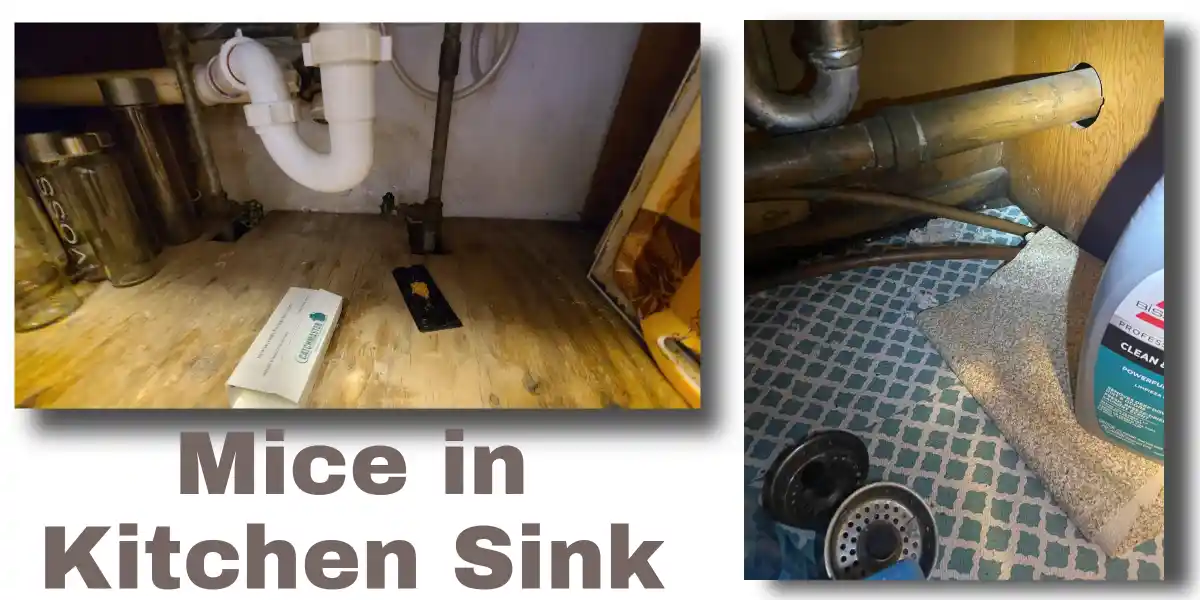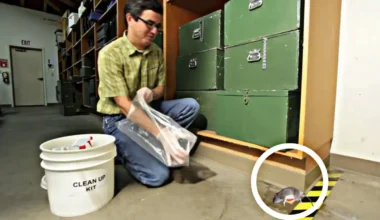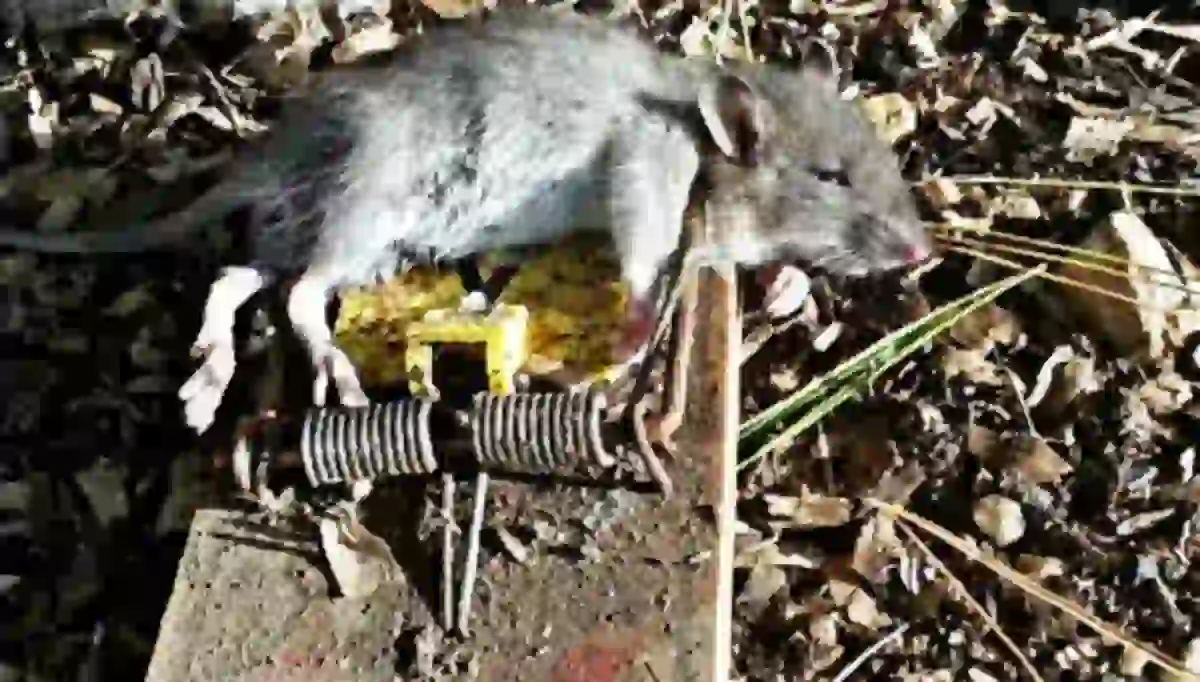Have you seen any signs of mice in your kitchen recently? Maybe you found tiny mouse poop on the kitchen floor or noticed things that look like they have been mouse-nibbled. Mice tend to hang out a lot under kitchen sinks, so if you spot droppings or other signs there, they might have been busy in your kitchen. And in this guide, you will learn how to get rid of mice under kitchen sink in simple steps.
Dealing with mice in your home can be bothering, but it is not impossible to solve the problem. You can take care of getting rid of mice if you know what to do.
We have carefully and expertly designed this piece of information on how to effectively remove mice under the kitchen sink. If you follow these steps correctly, you can get rid of these critters fairly quickly.
How to Get Rid of Mice Under Kitchen Sink

These simple methods below will help you get rid of mice under kitchen sink:
1. Make Sure to Close Holes and Cracks Properly
Start by walking around your house and looking for holes and cracks mouse use to access your kitchen. Mice are finding a way to come into your home, so you need to locate that spot. Even if you get rid of the mice inside, more could still come in from outside. It’s really important to fix this problem if you want to stop the mouse issue from growing.
Walk around your home’s outside and search for holes and cracks. You might need to go around a few times, even looking for tiny cracks or holes. Mice are skilled at fitting into small spaces. Even if a hole seems too small, a mouse could still use it to get in.
Basically, if a mouse can put its head in a hole or crack, it can get in. Keep in mind that some mice are smaller than others. Moreover, mice can generally A mouse can get through a small, 6-7 mm hole (about the diameter of a normal-sized pen) – Anticimex.
Closing cracks and holes will need some time and work. If you can, try to fully fix them. If you can’t fix them yourself, you can get a sealant to fill the cracks and stop mice from coming in. Foam sealant is something some people use for mouse holes.
Centers for Disease Control and Prevention (CDC) recommends the following measures:
- Seal any holes you find to stop mice from breaking into your kitchen.
- Plug holes using steel wool.
- Caulk up around the steel wool to keep it in place or use spray foam.
- Use lath screen or lath metal, cement, hardware cloth, or metal sheeting to fix larger holes.
- Cut material to fit around pipes.
- Fix gaps in trailer skirting and use flashing around the base of the house.
- Outbuildings and garages should also be sealed to prevent the entrance of rodents.
2. Clean Your Kitchen Thoroughly
After sealing the possible entries to get rid of mice under kitchen sink, make sure to clean up. Mice like homes with food and water they can use. When your home is clean, they won’t find easy food sources. Sometimes it’s easy to forget chores and leave crumbs on the counters and floor in the kitchen.
Vacuum to pick up crumbs and sweep and mop the kitchen and bathrooms. Also, wash dishes right away instead of leaving them in the sink. If you have a dishwasher, load dishes in each night and run it.
You can make it harder for mice to find food by protecting your food. Store cereal in sealed plastic containers and protect other types of food too. If you have pets, do not leave pet food in bowls since mice will eat it if given the chance.
Keep an eye on your garbage cans too, as mice might try to get in. Use garbage cans with tight-sealing lids to prevent them from getting into the trash and eating it.
3. Consider Placing Mouse Traps
Using mouse traps under the kitchen sink can get rid of mice. Since you have seen their droppings there, it’s a good spot for traps. You can find various mouse traps to buy, but a regular spring trap is probably your best choice.
You have probably seen these types of mouse traps before. They’ve been used for a long time. They work by a plate that’s pushed down, and a piece of metal hits the mouse. Also, you will need to put bait on the trap to attract the mice. Some people use cheese, but peanut butter is actually better.
Peanut butter sticks well to the trap (sometimes they don’t work if not handled well), and mice have to struggle to get it off. It also sticks to their teeth, making them stay longer. Using peanut butter makes it more likely that the trap will work and catch the mouse. After you set up the traps, you just have to wait and see if it works.
Look the next morning to see if there’s a dead mouse in the trap. Also, check if the bait is gone. Put the traps where your pets can’t get to them, like under the sink.
You can also think about using traps that catch mice without hurting them. You can let the mouse go outside once it’s caught. But remember, if you release it, it might come back into your home later. Some people prefer not to harm animals. You can choose what feels right for you. Meanwhile, we reviewed the best mouse trap for your kitchen, with general safety in mind.
4. Poison-bait the Critters
You could use poison to get rid of mice under kitchen sink. Just purchase special rodent poison meant to kill mice when they consume it. Some types of mouse poison are made to be accessible to mice but not other pets. These products are sometimes called “stations,” and they allow mice to access and consume poison blocks.
The block smells good to mice, so they eat it. After a while, they die from eating it. This can be helpful if you have lots of mice. But using regular mouse traps with bait might still be easier.
Some folks are concerned that their pets or kids might get sick from this poison. If that worries you, you can stick to using traps and not use poison stuff. If using poison, make sure it is set in a bait station.
5. Bring in a Cat
A cat is another reasonable way to remove mice under your kitchen sink. Cats are natural hunters and will chase mice without giving up. If you have a cat at home, it’s likely to go after mice that come inside. You might wake up to the cat showing you a mouse it caught.
Cats like to bring their owners dead mice to get praised. They might leave the mouse by your bedroom door to show off.
If you cheer them on, your cat will keep hunting mice that come inside. Just make sure your cat doesn’t eat the mice, as that’s not good. Know that not all cats are great at catching mice. Some might be too lazy or picky to chase mice, but many cats are really good at hunting them.
Keep in mind that having a cat is a big responsibility. It costs money to care for a pet, and you’ll need to give the cat attention to keep it happy.
Don’t get a cat just to make it catch mice. Only bring a cat into your home if you truly want one and have enough time to care for it.
6. Use Ultrasonic Repellent Devices
Even noise can make mice leave. You would need to get an ultrasonic repellent device that plays sounds that mice don’t like, so they stay away from your home. You can buy one of these devices and put it in your kitchen. Some of them can plug into the wall and work inside your house.
Many of these devices have options to make sounds that humans can’t hear. So, if you want to give it a shot, it shouldn’t bother you.
However, it might disturb your pets, like dogs or cats. In that case, this kind of device might not be the best choice for your home. If you don’t have pets, using these devices could work well for you. Mice might decide to avoid your home completely because of the sounds from the device.
7. Use Plants and Fragrances to Deter Mice
You can make mice stay away by using specific plants and scents. Mice really do not like the smell of garlic. If you don’t want mice near your home, you can plant garlic close to your house. And if you don’t want garlic plants, there are other strongly scented plants that can work too.
You can put lavender plants around your house to stop mice from coming close. Taking care of these plants is simple, and they might stop mice from trying to come inside. If mice are already in your home, you can put lavender inside and under the kitchen sink. Using peppermint oil is another way to make mice want to leave.
Making mice feel uncomfortable so they’ll want to go away could be a good plan. But using these things to stop mice from coming in might be easier.
Putting specific plants around your house is a smart move. It’s like creating a barrier that could stop mice from getting inside your home.
Remember, this might not work perfectly all the time. Some mice might not mind the smell and will still look for food in your home. Mice will do what they need to survive. Even though it might not always work, trying this could still make a change. If you can take care of plants, it’s worth giving it a try.
What Attracts Mice to Your Kitchen Sink?
There’s always food in the kitchen, so remember that when you decide not to wash dishes or clean up after cooking. Don’t make it tempting for pests. Warm and cozy spots like under cabinets, including the sink cabinet, attract them. It’s a bit like those cartoons where mice live behind walls. If your kitchen is on a second floor, it’s harder for them to get there, though not impossible.
Mostly, mice crawl into kitchen sinks on the first floor. This happens especially when you leave food lying around and don’t mow the lawn behind the kitchen for a while.
Signs of Mice Infestation in Your Kitchen
While you can get rid of mice under kitchen sink, you need to know whether you have a possible infestation. If yes, you need professional intervention to permanently keep mice away. Mice are a threat to health, so you don’t want your kitchen utensils or food exposed to them.
Here are a few helpful signs to show it’s mice, not a ghost.
1. An Unusual Bad Odor
Absolutely. Rodents have a distinct smell in their poop and pee. The bad smell might be in just one spot or all over your kitchen, depending on how much they have left behind. If you have pets like cats and dogs, they might get curious about the smell and head to the same area a lot.
2. The Black Poop of Mice
Here’s a definite sign of mice around. If you touch it, it falls apart easily. Mice leave lots of poop where they eat and hide. You will discover their droppings under the kitchen sink, in cabinets, near open food containers, and around leftover food.
Mice also poop while they are scurrying around, so you might spot their droppings along their usual paths. Also, old or fresh poop can tell whether you have a growing or an existing infestation. We detailed how to tell a fresh mouse poop for you.
3. Scratching Sounds
When mice are under your kitchen sink, you might hear scratching when you turn off the lights and walk away. If the mice were gone for a bit and returned at night, you’ll hear scratching, rustling, or digging sounds at night. Sometimes, you might also hear little squeaks with the sounds.
4. Gnawing Signs and Tunnels
- You might notice bite marks on food, food packages, and wooden cabinets.
- You’ll also come across tunnels in places like doors, windows, and corners of the house.
- Mice have tiny teeth, while rats have bigger teeth, so their marks look deeper and stand out.
- How noticeable the nibbles are depends on how many mice nibbled on the food – they can be light or go in deep.
5. Mice’s Track for Running
Sometimes, when mice run around, you might suddenly pay attention and realize they’re invading your space. You can check for their paths, which might be there or not. Use a flashlight to look closely. You might see droppings, smell urine, or find bits of fur along the paths they take.
If you think there might be mice around, put some flour or powder where you suspect. You’ll see their footprints or marks. You might see one or all of these signs. If there are lots of mice, you’ll easily see these signs without needing anything special.
Final Thoughts
When you want to get rid of mice under kitchen sink, you have a few things you can do – as mentioned in this post. Start by closing up any holes and cracks so the mice can’t come in or go out. Keep your house very clean so they can’t find food easily. After that, put traps under the sink to catch the mice and finish the job. Some people might use poison instead of regular traps, and some let their cats catch the mice. You could also try using things to keep the mice away from your home.





